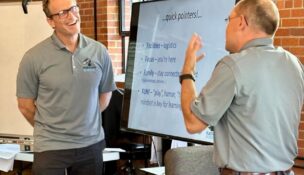Yandle: Economic health tied to trade concerns
Staff //July 16, 2018//
Editor's note: This story first appeared in the July 9 issue of GSA Business Report.
The “sleepwalking economy” is picking up some speed, according to economist Bruce Yandle, who said he has a brighter outlook for the economy than he did this time last year.
“We’re moving from what I refer to as a sleepwalking economy to not quite one that is trotting, but improving and gaining some speed,” he told GSA Business Report.
 Yandle, who is Distinguished Adjunct Fellow for the Mercatus Center at George Mason University and dean emeritus of the Clemson University College of Business and Behavioral Science, wrote in his June 2018 Economic Summary, that we should expect to see 2.8% growth in GDP this year. It was 2.3% in 2017.
Yandle, who is Distinguished Adjunct Fellow for the Mercatus Center at George Mason University and dean emeritus of the Clemson University College of Business and Behavioral Science, wrote in his June 2018 Economic Summary, that we should expect to see 2.8% growth in GDP this year. It was 2.3% in 2017.
There are, however, two dark clouds that “make us hesitate,” he said. Those clouds are trade issues and general policy uncertainty. And the South Carolina economy is more vulnerable to those clouds than the nation as a whole.
“The economy here is different that the nation because of the international component. We are an exporter. Employment is generated by exports here,” Yandle said.
The top four countries receiving goods from South Carolina are China, Germany, Canada and Mexico, “all of which have been singled out by the president,” Yandle said. “Our economy is wrapped up in a global network. For example, a big part of BMW vehicles are sent to China – people in China are big buyers of BMWs.”
Yandle said South Carolina is seeing some trail off in manufacturing growth in the state, and that the “blips” have to do with risks of a trade war.

“Exposure to that risk is greater for South Carolina than the nation because jobs here are supported by exports,” he said. “There is uncertainty in how all of this will play out. The nation is in a strategic bargaining situation. I hope we are halfway through this process. Statements made have been extreme, making it sound like the beginning of a trade war. The cloud is rather dark.”
South Carolina’s economy has outperformed the nation for some time, driven by population growth, according to Yandle. Between 2010 and 2016, three states east of the Mississippi River outperformed the nation – South Carolina, North Carolina and Florida. And, data from a United Van Lines study of household movement shows South Carolina is the No. 7 state on list of top states people are moving to. The state’s GDP growth is driven by growth in the workforce and the population, evidenced by the fact that more are coming here than leaving here, according to Yandle.
“However, some of the edge is being taken off because of trade concerns,” he said.
In his economic summary, Yandle writes “since the first of the year, the Trump administration has imposed tariffs on Canadian dairy products and Chinese solar panels and washing machines; has threatened world tariffs with negotiated exceptions for steel and aluminum imports, and most recently has called for tariffs on foreign-produced automobiles. Along with these comes a growing list of tariffs on multiple Chinese goods, followed, of course, by threats of Chinese and European Union retaliation. America’s trade disputes raise serious questions regarding economic growth over the next two years.”
Yandle said some policy decisions have helped the economy, and those include corporate tax cuts and reductions in regulations. He said the load has been reduced for small banks. And changes in environmental regulations have provided the economy some relief on the cost side.
“The number of pages in the federal register in 2017 saw a decline from 2016 — for first time since the 1930s,” he said.
In summarizing his mid-year economic outlook, Yandle believes:
- GDP growth will average 2.8%.
- Inflation will rise a bit. Look for 2.5% by year end.
- Interest rates will nudge up. By year’s end, the 10-year bond will yield 3.15% and 30-year mortgage rates will hit 4.3%.
- Housing will be strong, especially single-family construction and sales; auto production will be flat.
- The pace of manufacturing activity will accelerate, led by machinery.


















